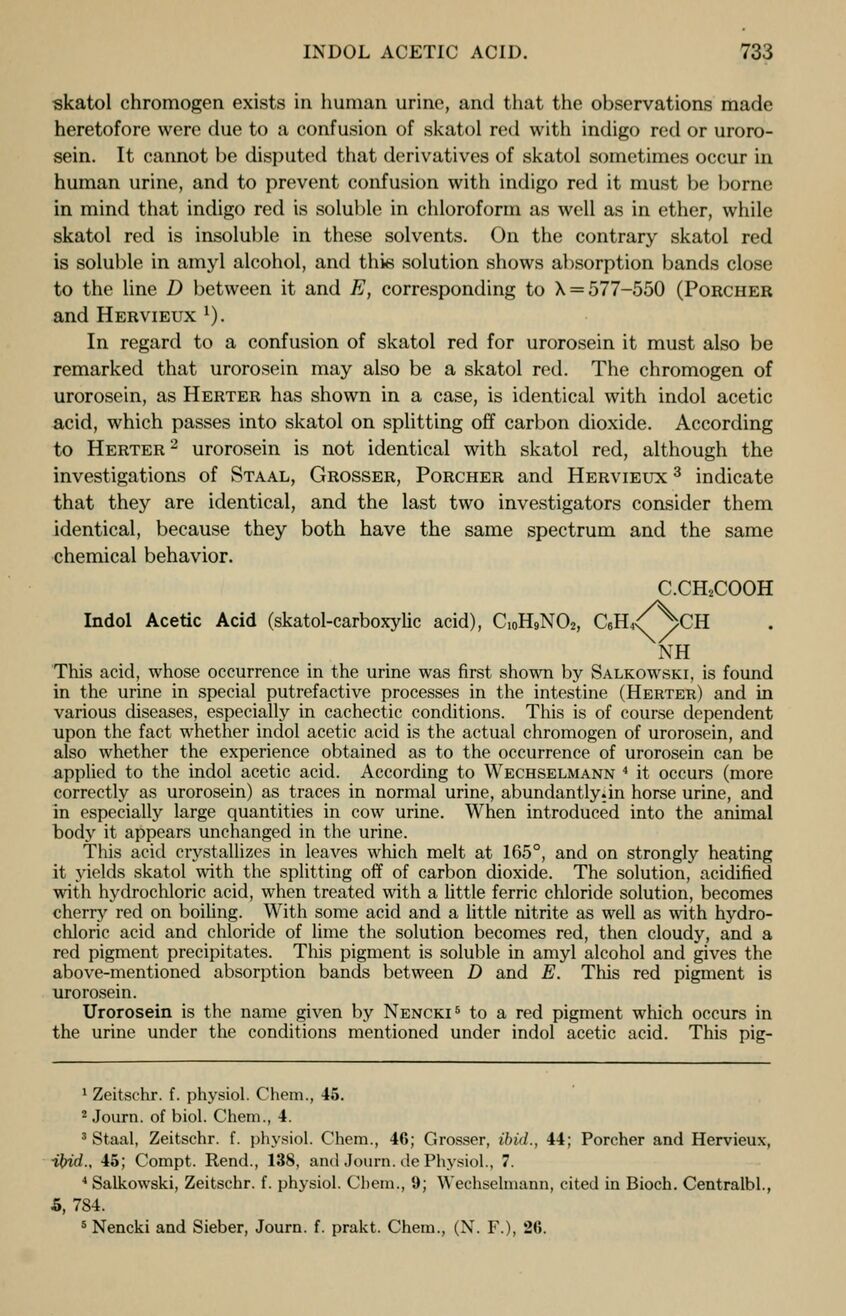
Full resolution (JPEG) - On this page / på denna sida - XIV. Urine - II. Organic Physiological Constituents of Urine

<< prev. page << föreg. sida << >> nästa sida >> next page >>
Below is the raw OCR text
from the above scanned image.
Do you see an error? Proofread the page now!
Här nedan syns maskintolkade texten från faksimilbilden ovan.
Ser du något fel? Korrekturläs sidan nu!
This page has never been proofread. / Denna sida har aldrig korrekturlästs.
INDOL ACETIC ACID. 733
skatol chromogen exists in human urine, and that the observations made
heretofore were due to a confusion of skatol red with indigo red or uroro-
sein. It cannot be disputed that derivatives of skatol sometimes occur in
human urine, and to prevent confusion with indigo red it must be borne
in mind that indigo red is soluble in chloroform as well as in ether, while
skatol red is insoluble in these solvents. On the contrary skatol red
is soluble in amyl alcohol, and this solution shows absorption bands close
to the line D between it and E, corresponding to X = 577-550 (Porcher
and Hervieux 1
).
In regard to a confusion of skatol red for urorosein it must also be
remarked that urorosein may also be a skatol red. The chromogen of
urorosein, as Herter has shown in a case, is identical with indol acetic
acid, which passes into skatol on splitting off carbon dioxide. According
to Herter 2
urorosein is not identical with skatol red, although the
investigations of Staal, Grosser, Porcher and Hervieux 3
indicate
that they are identical, and the last two investigators consider them
identical, because they both have the same spectrum and the same
chemical behavior.
C.CH2 COOH
Indol Acetic Acid (skatol-carboxylic acid), Ci H9 NO2, C6H4
\ /CH
NH
This acid, whose occurrence in the urine was first shown by Salkowski, is found
in the urine in special putrefactive processes in the intestine (Herter) and in
various diseases, especially in cachectic conditions. This is of course dependent
upon the fact whether indol acetic acid is the actual chromogen of urorosein, and
also whether the experience obtained as to the occurrence of urorosein can be
applied to the indol acetic acid. According to Wechselmann 4
it occurs (more
correctly as urorosein) as traces in normal urine, abundantly.in horse urine, and
in especially large quantities in cow urine. When introduced into the animal
body it appears unchanged in the urine.
This acid crystallizes in leaves which melt at 165°, and on strongly heating
it yields skatol with the splitting off of carbon dioxide. The solution, acidified
with hydrochloric acid, when treated with a little ferric chloride solution, becomes
cherry red on boiling. With some acid and a little nitrite as well as with hydro-
chloric acid and chloride of lime the solution becomes red, then cloudy, and a
red pigment precipitates. This pigment is soluble in amyl alcohol and gives the
above-mentioned absorption bands between D and E. This red pigment is
urorosein.
Urorosein is the name given by Nencki 5
to a red pigment which occurs in
the urine under the conditions mentioned under indol acetic acid. This pig-
1
Zeitschr. f. physiol. Chem., 45.
2
Journ. of biol. Chem., 4.
3
Staal, Zeitschr. f. physiol. Chem., 46; Grosser, ibid., 44; Porcher and Hervieux,
ibid., 45; Compt. Rend., 138, and Journ. ile Physiol., 7.
4
Salkowski, Zeitschr. f. physiol. Chem., 9; Wechselmann, cited in Bioch. Centralbl.,
5, 784.
5
Nencki and Sieber, Journ. f. prakt. Chem., (N. F.), 26.
<< prev. page << föreg. sida << >> nästa sida >> next page >>